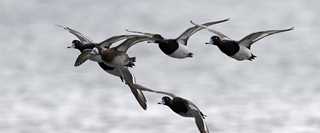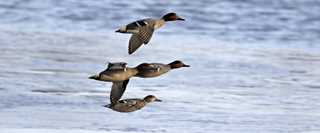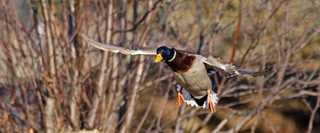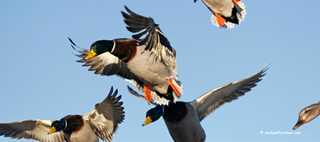Mississippi Flyway Public Waterfowl Hunting Hotspots for 2017-2018
5 public hunting destinations you may want to explore
5 public hunting destinations you may want to explore

By Chris Jennings
The Mississippi Flyway hosts millions of migrating and wintering waterfowl each year, and while hunting pressure can be intense, great opportunities still exist for freelance waterfowlers who are willing to work for their birds. The following five hotspots offer some of the finest waterfowling in the flyway thats open to the public.

Photo Michael Furtman
Best known for its world-class walleye fishing, Lake of the Woods also offers outstanding public waterfowl hunting. Located along the Canadian border in close proximity to the Prairie Pothole Region, the lake attracts large numbers of dabblers and divers, and numerous public boat ramps give hunters easy access to prime hunting areas.
There are nearly 300,000 acres of public hunting land on the U.S. side of the lake, which includes shoreline, marshes, bogs, and tributaries of the lake. We get a lot of local birds early and the northern birds show up as the locals move out, says Paul Johnson, owner and operator of River Bends Resort and Walleye Inn in Baudette. We get the divers coming out of Canada, and this is really the first crack U.S. hunters get at these birds, which have received little or no pressure.
In the afternoons, waterfowl hunters can sample the lakes legendary walleye fishing or hunt grouse and woodcock on more than 1 million acres of state and U.S. Forest Service land in the area. As the season progresses and the pace of the migration increases, large concentrations of scaup and other diving ducks use the lake as a staging area before bitter cold temperatures, snow, and ice send the birds south.
The hunting improves later in the season, Johnson says. Four Mile Bay, which is near our lodge, gets really good right before freeze-up.
For more information, visit http://www.dnr.state.mn.us/index.html or https://lakeofthewoodsmn.com/.

Photo Michael Furtman
Pointe Mouillee State Game Area, which was originally a private duck club that is now owned and managed by Michigan Department of Natural Resources (DNR), is an extensive waterfowl habitat complex on the western shores of Lake Erie. This 4,040-acre property offers good public hunting opportunities for a variety of waterfowl species in different habitat types.
The Michigan DNR does a great job of managing hunters and hunting pressure through the draws at Pointe Mouillee, says Jason Hill, a DU regional biologist in Michigan. The habitat consists of a mix of natural wetlands and agricultural crops, which is attractive to puddle ducks, but there are also deep-water areas where diving ducks can be hunted.
Located near the mouth of the Detroit River on Lake Erie, Point Mouillee is a crucial staging area for waterfowl migrating through the Great Lakes watershed.
Weve completed several North American Wetlands Conservation Act (NAWCA) projects in the area, Hill says. We have an active project going on there now, and one that we just finished. Ive hunted there myself and harvested everything from green-winged teal and mallards to canvasbacks and bluebills. The diversity of species is a testament to the habitat quality.
But Point Mouillee isnt the only attraction for waterfowlers in the area. Good public hunting is also available on the Detroit River and Lake Erie itself for those with the equipment and the know-how to safely hunt the big water. Waterfowl numbers typically peak in the area during late October and early November.
For more information, visit http://www.michigan.gov/dnr/0,4570,7-153-10370_62146_62150-283172--,00.html.

Photo Michael Furtman
Oakwood Bottoms Greentree Reservoir is managed by the U.S. Forest Service (USFS) as part of Shawnee National Forest. Spanning more than 3,500 acres, its the largest actively managed greentree area in Illinois and one of the largest remaining tracts of bottomland hardwood forest in the region. Oakwood Bottoms is located in the confluence floodplain between the Mississippi and Big Muddy Rivers, which is a conservation priority area for DUs Big Rivers initiative. DU and its partners have completed several wetland restoration and enhancement projects in the area with funding from NAWCA and foundation grants.
The USFS manages Oakwood Bottoms as part of a landscape consisting of bottomland hardwood forest, ridge and swale wetlands, and permanent swamp, explains Mike Sertle, DUs regional biologist for Illinois and Indiana. The area itself consists of several greentree management units (GTUs). There are also clearings and openings scattered throughout Oakwood Bottoms that provide a moist-soil component. Waterfowl use the area primarily for migration, both in fall and spring, but birds are also wintering there in increasing numbers.
Hunting at Oakwood Bottoms is walk in only, with no motorized boats or ATVs allowed. Water levels are managed to be no more than two feet deep, but there are ditches that can make for deeper wading. Mallards and wood ducks are the most abundant species in the timber, while gadwalls, green-winged teal, shovelers, and pintails visit moist-soil areas.
If I have a spot that I know ducks are using, then I start walking in about legal shooting time, explains Sertle, who regularly hunts at Oakwood Bottoms. If I dont, I prefer to wait until the sun comes up and let the birds and other hunters dictate where I go.
Hunters should be cautious when attempting to hunt Oakwood Bottoms for the first time. The area is large and finding your way around can be challenging. In addition, not all the area is flooded each year, and some tracts are flooded later in the season.
This years habitat is looking excellent, with a good crop of mast and moist-soil plants. All of the GTUs are in varying degrees of active forestry management, so some GTUs have a lot of recently downed brush and timber that will be underwater when its flooded, Sertle says. Be sure to check the regulations before you hunt, as there are specific entry and exit times, no-hunting areas, and other rules that apply.
For more information, visit https://www.fs.usda.gov/detail/shawnee/home/?cid=stelprdb5440442.

Photo Michael Furtman
Southeast Missouris Duck Creek Conservation Area (CA) and Mingo National Wildlife Refuge (NWR) provide a wealth of public hunting opportunities in what has become one of the nations hottest waterfowling areas. Managed by the Missouri Department of Conservation (MDC), Duck Creek CA consists of 3,816 acres of waterfowl habitat. Hunting spots are allotted via the MDCs online lottery system and during daily draws held onsite. Neighboring Mingo NWR encompasses 21,592 acres, the vast majority of which are not open to hunting. However, Pools 7 and 8 on the refuge offer exceptional green timber hunting, which is managed through daily draws held on Duck Creek CA.
The staff does a great job managing the property and the draw at Duck Creek and Mingo, says Matt Bowyer, the MDCs wildlife regional supervisor for southeast Missouri. The properties sit right next to each other and the draws can get crowded, but the hunting on Duck Creek and Mingo can be very good.
The MDC, USFWS, and other partners have worked hard to enhance waterfowl habitat on these areas with funding provided by the state and NAWCA grants. Bowyer notes that many of the greentree units are not flooded until later in the season when the timber is dormant. This reduces stress on the oaks and other bottomland hardwood species that provide vital habitat for waterfowl and other wildlife.
The habitat is very diverse, with timber, moist-soil units, and natural marsh. This leads to diverse waterfowl bags, Bowyer says. Early in the season the moist-soil areas draw good numbers of green-winged teal, shovelers, gadwalls, and other puddle ducks. The wood duck numbers are spectacular in the timber, and by mid-December bags consist largely of mallards.
Bowyer explains that the best way to learn more about hunting opportunities at Duck Creek CA and Mingo NWRincluding information about drawings and maps showing designated hunting areas and blind locationsis to visit the MDCs website at https://mdc.mo.gov/.

Photo Michael Furtman
Located in the legendary Mississippi Delta, 40,000-acre Panther Swamp National Wildlife Refuge (NWR) is among the largest public waterfowl hunting areas in the Southeast. The sprawling tract is one of the seven refuges in the 100,000-acre Theodore Roosevelt National Wildlife Refuge Complex, which is owned and managed by the U.S. Fish and Wildlife Service. Panther Swamps diverse habitats, which include seasonally flooded bottomland hardwood forest, bayous, and cypress-tupelo swamps, make the refuge a major wintering area for mallards, wood ducks, and other dabbling ducks.
Panther Swamp offers some of the best waterfowl hunting opportunities on public land in the Southeast, says Seth Swafford, deputy project leader/refuge manager for the Theodore Roosevelt NWR Complex. Waterfowl hunting improves later in the season, as migratory waterfowl typically arrive in large numbers around mid-December. Many hunters enjoy hunting mallards but also look forward to adding wood ducks to their bag.
Panther Swamp is a vast property that can be difficult to hunt due to the nature of the terrain and changing water levels. Despite these challenges, the refuge offers relatively good access for waterfowlers.
Hunters can use ATVs and UTVs on assigned trails and launch motorized boats at several boat ramps, Swafford says. There are also unimproved areas where hunters can walk in or use car-top boats like pirogues and small canoes.
Swafford stresses that the refuges focus is to provide for the needs of migratory waterfowl. Both resting and hunting areas consist mainly of bottomland hardwood forest and swamp, but also include intensively managed habitats, such as moist-soil units and flooded agricultural crops. Panther Swamp is very susceptible to backwater flooding, and this past summer was unusually wet. As a result, the refuge is holding a little more water than normal for this time of year, and unless the weather is exceptionally dry this fall, the habitat should be in good shape for duck season.
Hunters who are unfamiliar with the area should arrive several days in advance and scout extensively, Swafford says. Be prepared for high public use. This is one of the most popular areas in the Southeast for deer and squirrel hunting as well as waterfowl. As sportsmen and conservationists, we need to respect our fellow hunters.
For more information, visit https://www.fws.gov/refuge/Panther_Swamp/.
Ducks Unlimited uses cookies to enhance your browsing experience, optimize site functionality, analyze traffic, and deliver personalized advertising through third parties. By continuing to use this site, you agree to our use of cookies. View Privacy Policy